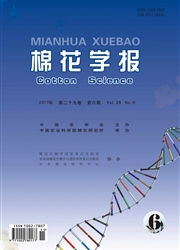

 中文摘要:
中文摘要:
【目的】为探讨不同盐度土壤土著丛枝菌根(Arbuscular mycorrhizae,AM)真菌对苗期棉花根系形态的影响。【方法】采用in-growth生长系统进行了田间原位研究。【结果】低盐(σ1.0 m S·cm~(-1))、中盐(σ2.1 m S·cm~(-1))、高盐(σ4.0 m S·cm~(-1))土壤条件下,土著AM真菌侵染显著增加了棉花株高、叶片数、蕾数、叶面积指数,说明土著AM真菌能够改善棉花的生长提高耐盐能力。土著AM真菌显著提高了总根长、根体积、根表面积以及直径(d)≤0.5 mm细根根长,低盐土壤条件下土著AM真菌显著增加了d≤0.5 mm细根的根长占总根长的百分比。相关分析表明,棉花总根长、d≤0.5 mm的细根根长与菌根侵染率、叶片磷、钾浓度及吸收量呈显著正相关,与叶片钠浓度呈显著负相关关系;棉花总生物量与叶片吸磷量、吸钾量极显著正相关。【结论】上述结果说明盐渍化土壤中的土著AM真菌侵染对棉花植株的磷、钾等营养状况的改善和棉株钠、氯效应的降低,与土著AM真菌促进细根生长、提高细根根长占总根长的比例有关。
 英文摘要:
英文摘要:
[Objective] In this study, we explored the effects of the soil indigenous arbuscular mycorrhizae(AM) fungal community on cotton root morphology and architecture at the seedling stage. [Method] A pot test at a field site was conducted using the in-growth system and included static(AM fungal colonization allowed freely) and vibrating(patting the top core edge twice every day to break any extradical hyphae attempting to access core) treatments in slightly(Electrical conductivity σ 1.0m S·cm~(-1)), highly(σ 2.1 m S·cm~(-1)), and extremely(σ 4.0 m S·cm~(-1)) saline soils. [Result] The results indicated that colonization of indigenous AM fungi was accompanied by an increase in cotton plant height, leaf number, bud number, and leaf area index,and improved salt resistance. Indigenous AM fungi symbiosis significantly increased total root length, root volume, root surface area, and the length of fine roots with a diameter(d) ≤0.5 mm compared with the control(vibrating treatment). The percentage of the root length with a d ≤0.5 mm under the static treatment was significantly higher than under the vibrating treatment in slightly saline soil but not with highly and extremely saline soils. Correlation analysis results showed significant positive correlations between both total root length, root lengths with a d ≤0.5 mm and root colonization of AM fungi, leaf P/K content.A positive correlation was also observed between total biomass and leaf P/K content, while a significant negative correlation was observeds between both total root length, root lengths with a d ≤0.5 mm and leaf Na concentration. An indigenous AM fungal community was advantageous to cotton total root length and fine root growth in saline soils, improved P/K status, reduced Na/Cl salt absorption, and increased salt resistance. [Conclusion] These results suggest that increasing root length and the percentage of fine roots through the introduction of symbiotic indigenous AM fungi may improve P/K status and r
 同期刊论文项目
同期刊论文项目
 同项目期刊论文
同项目期刊论文
 期刊信息
期刊信息
